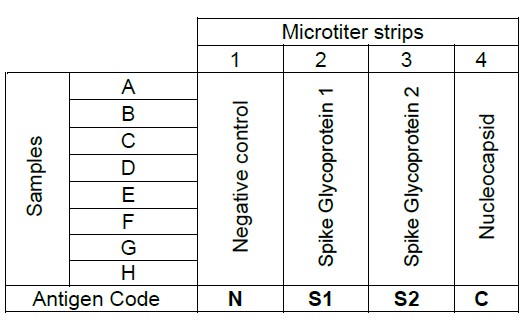

Anti-SARS-CoV-2 (S1, S2, N) IgG ELISA Assay Kit
Anti-SARS-CoV-2 (S1, S2, N) IgG ELISA Assay Kit is Developed and Manufactured by Generic Assays
Size: 96 wells (24 samples x 4)
Incubation Time: 2 hours
Sample Type: Serum or Plasma
Number Of Samples Per Kit: 24 (22 samples + controls)
Sample Size: 50 µl
For Research Use Only
Controls Included
Assay Principle
Anti-SARS-CoV-2 (S1, S2, N) IgG ELISA Assay Kit is a reagent kit for the determination of IgG antibodies against immunodominant major antigens of the SARS coronavirus-2. The test kit consists of modules separately coated with the major antigens of the virus:

The samples are pipetted horizontally over the 4 strips of a module (e.g. A1+A2+A3+A4), any antibodies present react with the specific antigens bound to the solid phase in the first reaction step. Unbound sample components are removed by a wash step after 45 minutes incubation at 37 °C.
The bound IgG antibodies react specifically with anti-human-IgG conjugated to horseradish peroxidase (HRP). Within the incubation period of 45 min at 37 °C, excessive conjugate is separated from the solid-phase immune complexes by the following wash step.
HRP converts the added colorless substrate solution of 3,3’,5,5’-tetramethylbenzidine (TMB) into a blue product. The enzyme reaction is stopped by dispensing an acidic solution into the wells after 15 min at room temperature (18-25 °C) turning the solution from blue to yellow.
The optical density (OD) of the solution measured at 450 nm is directly proportional to the amount of specific antibodies bound.
Specimen collection and storage
Blood is taken by venipuncture. Serum is separated after clotting by centrifugation. Plasma samples (citrate, EDTA, heparin) can be used too, too. Hyperlipemic, hemolytic or contaminated samples must not be used and the samples must not contain preservatives.
Samples can be stored up to 5 days at 2 – 8 °C in the primary tubes. For longer storage, sera or plasmas extracted from the primary tubes must be frozen at -20°C. Repeated freezing and thawing should be avoided. If necessary, aliquots should be prepared before freezing.
Samples are diluted during the Anti-SARS-CoV-2 (S1, S2, N) IgG ELISA test, controls should not be diluted.
Related Products
Coronavirus COVID-19 IgG ELISA Assay
Coronavirus COVID-19 IgM ELISA Assay Kit
Anti-SARS-CoV-2 S1 (RBD) IgG ELISA Assay
EagleBio的5α-雄甾烷-3α,17β-二醇葡糖醛酸化物是C19类固醇,缩写为3α-DiolG,5α二醇G或简称为α二醇G。它主要作为睾丸激素和二氢睾丸激素(DHT)的代谢产物生产。它主要在目标外围组织(例如皮肤)中产生,尤其是在毛囊周围。大量的3α-DiolG刺激会导致过多的头发形成,特别是在女性通常不存在头发的地方。近年来,在研究患有特发性多毛症的妇女的临床研究人员中,人们对这种类固醇的测量越来越感兴趣。已知是3α-DiolG前体的类固醇包括脱氢表雄酮(DHEA),硫酸脱氢表雄酮(DHEAS),二氢睾丸酮(DHT),雄烯二酮和睾丸激素。已显示只有3α-DiolG随多毛症增加而随治疗减少。这种相关性在多囊卵巢综合征(PCO)患者中也得到了证明。3α-DiolG的测定因此被证明是多种方式的有用指标,包括监测特发性多毛症和PCO妇女的治疗进展。此外,接受环孢霉素A治疗的糖尿病患者(无论男女)均显示3α-DiolG水平升高,这种副作用导致以前无毛的区域出现了头发。3α-DiolG的测定因此被证明是多种方式的有用指标,包括监测特发性多毛症和PCO妇女的治疗进展。此外,接受环孢霉素A治疗的糖尿病患者(无论男女)均显示3α-DiolG水平升高,这种副作用导致以前无毛的区域出现了头发。3α-DiolG的测定因此被证明是多种方式的有用指标,包括监测特发性多毛症和PCO妇女的治疗进展。此外,接受环孢霉素A治疗的糖尿病患者(无论男女)均显示3α-DiolG水平升高,这种副作用导致以前无毛的区域出现了头发。



